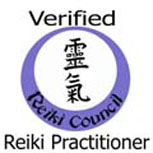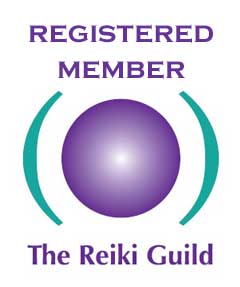What is Reiki?
What Is The Difference Between Western & Japanese Reiki?
What Are Reiki Attunements?
Why Do A Combined Reiki Level I & Level II Course?
What Are The Benefits Of Reiki?
Can Therapists Use Reiki With Other Treatments?
Can Anyone Learn Reiki?
What Is A Reiki Lineage?
What Is Your Reiki Lineage?
What is Reiki?
Reiki is a natural form of energy healing, using varying frequencies of energy to
heal at all levels. The energy used in Reiki is believed to be Universal Energy.
This energy is channelled by the practitioner and directed through
the practitioner's hands to wherever it is needed. The system of Reiki was developed
by Mikao Usui after his sartori (enlightenment) on Mount Kurama in 1920's Japan.
Reiki has spread throughout the world as a respected form of healing used by
many thousands of people, and some hospitals and clinics.
Top
What Is The Difference Between Western & Japanese Reiki?
Japanese Reiki is much more intuitive and genuinely spiritual, in line with Japanese
culture. Western Reiki has, in many of its forms, had some of the spiritual teachings
removed and replaced with a mix of pseudo-spiritual and non-Japanese concepts.
The other main difference is that Japanese Reiki is used as a means of treating
injuries and illnesses directly, whereas Western Reiki is often used as a relaxation
therapy or as a means of balancing the 'chakras'.
Top
What Are Reiki Attunements?
Reiki attunements or
denju are adjustments made by the Reiki teacher to the
students energy body to connect them to the source of the energy and allow the flow of
energy from the Universe into the student. This allows the student to heal using
the Reiki energy and to develop themselves on every level to fulfill their higher path.
Once attuned, the student has a direct connection to the Highest Consciousness.
These are not to be confused with Reiju (a blessing) or empowerments. Reiju
empowerments apply energy to the student and bring the student closer to the source
of the energy a little at a time where as the Reiki attunements offer a direct connection.
Originally Mikao Usui taught his students on an ongoing regular basis (similar to his KiKo teaching)
so it made perfect sense to give them Reiju empowerments generally on a weekly basis, raising their frequency a little
at a time as they learn Reiki.
As Mikao Usui developed his understanding of his new method for healing, he introduced the denju
or attunement process. This meant he could teach Reiki on short courses (as people are taught in the
Western World) the Reiki attunements were used as a direct and immediate connection
to the source of the energy.
Top
Why Do A Combined Reiki Level I & Level II Course?
There are a number of reasons why it is more beneficial for a student to take
level 1 and level 2 as a combined course:
When a student is attuned to Reiki, whether on a short course over one or two
days or on a longer course over many weeks, a cleansing and healing process takes
place over a period of time. This is called the "21 day cleansing process" or the
"Reiki healing crisis" and lasts as long as each individual needs. The more
self-healing that is done over this time, the easier and shorter the process is.
Level 1 does not actually teach Reiki healing using the Usui symbols, only Rei
healing (spiritual healing) is taught. Level 2 teaches Reiki healing for physical,
emotional, mental and spiritual conditions, allowing the student to heal themselves
much more effectively during (and after) the cleansing process.
Very few students will be sensitive enough to feel the energy used at level 1.
We find that students get disillusioned with Reiki when they have only taken
level 1 because they cannot feel the energy and are disappointed with the healing
effects. Level 1 is more a relaxation treatment, rather than the healing treatment
possible at level 2.
Level 1 is not a complete or stand-alone course, and as such it only teaches part
of the Reiki system. Mikao Usui said Light and Ki energy flows from the healers hands,
eyes and breath. Level 1 teaches the Light component and level 2 teaches the Ki
component. Both are needed to be able to use Reiki effectively. This is much
closer to the way Dr Usui taught Reiki.
Top
What Are The Benefits Of Reiki?
Reiki has many benefits, both in a physical way and in a spiritual way. Once attuned,
the flow of Reiki energy gives continuous healing to the individual, on every level.
Self healing on a regular basis increases the flow, and the beneficial effects of
the Reiki energy. Generally, people tend to feel much less stressed, more
energized and much more focused. Life seems clearer, and life's purpose is more
apparent. Reiki is a life changing event, the start of a spiritual journey of
self discovery and enlightenment. Reiki gives the gift of attaining happiness.
Top
Can Therapists Use Reiki With Other Treatments?
Reiki works well with any form of healing treatment. Reiki enhances the benefits
of the therapists existing form of healing. Clients usually feel the difference
in the treatment they are receiving and often therapists offer Reiki healing as
an additional treatment.
Top
Can Anyone Learn Reiki?
Yes! The founder of Reiki Mikao Usui said:
"...a man, woman, young or old, people
with knowledge or without knowledge, anybody who has a common sense can receive
the power accurately in a short time and can heal selves and others. I have taught
to more than one thousand people but no one is failed."
I believe that anyone will be able to use Reiki energy.
Top
What Is A Reiki Lineage?
Reiki lineage refers to the line of Reiki Masters that leads to the student.
For traditional Reiki the line begins with Dr Usui, and continues with one of his
Reiki Masters, and then to one of theirs and so it continues. For a healing
system to be called Reiki and be recognized as such, the lineage must trace back
to Mikao Usui.
Top
What Is Your Reiki Lineage?
Japanese
Mikao Usui
Kanichi Taketomi
Kimiko Koyama
Hiroshi Doi
Allan J Sweeney
Andy Chrysostomou
Western
Mikao Usui
Dr Chujiro Hayashi
Mrs Hawayo Takata
Iris Ishikura
Arthur Robertson
Diane McCumber
William L Rand
Allan J Sweeney
Andy Chrysostomou
Top





